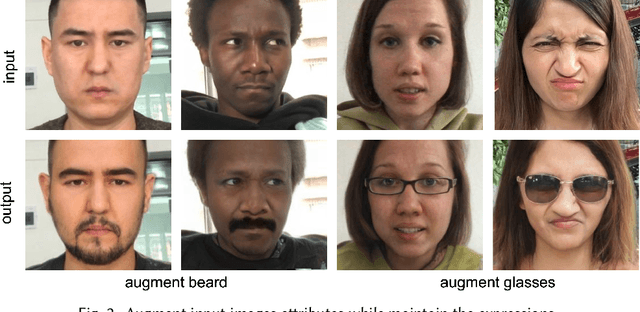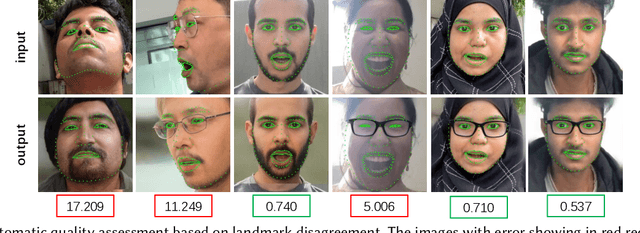Wan-Chun Ma
Using Augmented Face Images to Improve Facial Recognition Tasks
May 13, 2022



Abstract:We present a framework that uses GAN-augmented images to complement certain specific attributes, usually underrepresented, for machine learning model training. This allows us to improve inference quality over those attributes for the facial recognition tasks.
Learning Illumination from Diverse Portraits
Aug 05, 2020



Abstract:We present a learning-based technique for estimating high dynamic range (HDR), omnidirectional illumination from a single low dynamic range (LDR) portrait image captured under arbitrary indoor or outdoor lighting conditions. We train our model using portrait photos paired with their ground truth environmental illumination. We generate a rich set of such photos by using a light stage to record the reflectance field and alpha matte of 70 diverse subjects in various expressions. We then relight the subjects using image-based relighting with a database of one million HDR lighting environments, compositing the relit subjects onto paired high-resolution background imagery recorded during the lighting acquisition. We train the lighting estimation model using rendering-based loss functions and add a multi-scale adversarial loss to estimate plausible high frequency lighting detail. We show that our technique outperforms the state-of-the-art technique for portrait-based lighting estimation, and we also show that our method reliably handles the inherent ambiguity between overall lighting strength and surface albedo, recovering a similar scale of illumination for subjects with diverse skin tones. We demonstrate that our method allows virtual objects and digital characters to be added to a portrait photograph with consistent illumination. Our lighting inference runs in real-time on a smartphone, enabling realistic rendering and compositing of virtual objects into live video for augmented reality applications.
DeepLight: Learning Illumination for Unconstrained Mobile Mixed Reality
Apr 02, 2019

Abstract:We present a learning-based method to infer plausible high dynamic range (HDR), omnidirectional illumination given an unconstrained, low dynamic range (LDR) image from a mobile phone camera with a limited field of view (FOV). For training data, we collect videos of various reflective spheres placed within the camera's FOV, leaving most of the background unoccluded, leveraging that materials with diverse reflectance functions reveal different lighting cues in a single exposure. We train a deep neural network to regress from the LDR background image to HDR lighting by matching the LDR ground truth sphere images to those rendered with the predicted illumination using image-based relighting, which is differentiable. Our inference runs at interactive frame rates on a mobile device, enabling realistic rendering of virtual objects into real scenes for mobile mixed reality. Training on automatically exposed and white-balanced videos, we improve the realism of rendered objects compared to the state-of-the art methods for both indoor and outdoor scenes.
 Add to Chrome
Add to Chrome Add to Firefox
Add to Firefox Add to Edge
Add to Edge